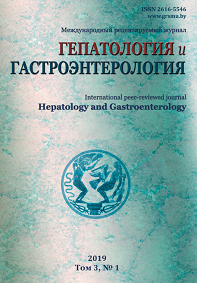RETROSPECTIVE ANALYSIS OF PNEUMONIA IN CIRRHOTIC PATIENTS
Abstract
Background. It is established, that pneumonia in patients with cirrhosis is more often associated with the development of impairment of consciousness, renal failure, septic shock and fatal outcome. Since low-grade fever, moderate leukocytosis (or increase of leukocyte count related to leukopenia) are frequent conditions in a patient with cirrhosis, an atypical clinical presentation of pneumonia is likely to be expected. neumonia in cirrhotic patients can be manifested by classic signs of cirrhosis decompensation: ascites, hepatic encephalopathy, variceal bleeding.The objective of the study is a retrospective analysis of pneumonia incidence and course in cirrhotic patients who died during hospital stay.
Materials and methods. We reviewed 308 autopsies of cirrhotic patients who died in a hospital environment. Cirrhosis was diagnosed using standard criteria (laboratory and instrumental methods, macro- and micromorphological signs).
Results. Pneumonia aggravated cirrhosis in 97 patients (31.5% of 95% CI 26.3-36.7) who died in a hospital environment and is the most common type of infectious complication. Moreover, sepsis and other infections were more common among patients with pneumonia as compared to those without it. A fatal outcome occurred shortly after admission in patients with pneumonia. It was rather difficult to confirm the diagnosis of pneumonia in some cases (15.5%; 95% CI 10.2-22.2). Most often these were nosocomial types of the disease.
Conclusion. The spectrum of pneumonia pathogens in deceased cirrhotic patients appeared to be characteristic of nosocomial infectious complications and immunocompromised patients.
References
1. Tandon P, Garcia-Tsao G. Bacterial infections, sepsis, and multiorgan failure in cirrhosis. Semin. Liver Dis. 2008;28(1):26-42. doi: 10.1055/s-2008-1040319.
2. Merli M, Lucidi C, Giannelli V, Giusto M, Riggio O, Falcone M, Ridola L, Attili AF. Cirrhotic patients are at risk for health care-associated bacterial infections. Clin. Gastroenterol. Hepatol. 2010;8(11):979-985. doi: 10.1016/j.cgh.2010.06.024.
3. Wong F. Acute kidney injury in liver cirrhosis: new definition and application. Clin. Mol. Hepatol. 2016;22(4):415-422. doi: 10.3350/cmh.2016.0056.
4. Garcia-Tsao G. Current Management of the Complications of Cirrhosis and Portal Hypertension: Variceal Hemorrhage, Ascites, and Spontaneous Bacterial Peritonitis. Dig. Dis. 2016;34(4):382-386. doi: 10.1159/000444551.
5. Kim HJ, Lee HW. Important predictor of mortality in patients with end-stage liver disease. Clin. Mol. Hepatol. 2013;19(2):105-115. doi: 10.3350/cmh.2013.19.2.105.
6. Falguera M, Trujillano J, Caro S, Menéndez R, Carratalà J, Ruiz-González A, Vilà M, García M, Porcel JM, Torres A; NAC-CALIDAD. A prediction rule for estimating the risk of bacteremia in patients with community-acquired pneumonia. Clin. Infect. Dis. 2009;49(3):409-416. doi: 10.1086/600291.
7. Kim YK, Kim Y, Shim SS. Thoracic complications of liver cirrhosis: radiologic findings. Radiographics. 2009;29(3):825-837. doi: 10.1148/rg.293085093.
8. Cardenas A, Arroyo V. Management of ascites and hepatic hydrothorax. Best Pract. Res. Clin. Gastroenterol. 2007;21(1):55-75. doi: 10.1016/j.bpg.2006.07.012.
9. Bonnel AR, Bunchorntavakul C, Reddy KR. Immune dysfunction and infections in patients with cirrhosis. Clin. Gastroenterol. Hepatol. 2011;9(9):727-738. doi: 10.1016/j. cgh.2011.02.031.


















1.png)






